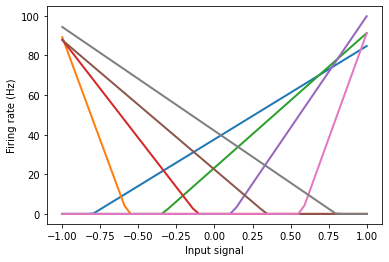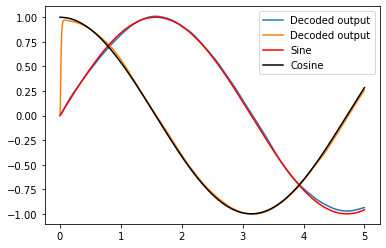Adding new objects to Nengo¶
It is possible to add new objects to the Nengo reference simulator. This involves several steps and the creation of several objects. In this example, we’ll go through these steps in order to add a new neuron type to Nengo: a rectified linear neuron.
Step 1: Create a frontend Neurons subclass¶
The RectifiedLinear class is what you will use in model scripts to denote that a particular ensemble should be simulated using a rectified linear neuron instead of one of the existing neuron types (e.g., LIF).
Normally, these kinds of frontend classes exist in either nengo/objects.py or nengo/neurons.py. Look at these files for examples of how to make your own. In this case, because we’re making a neuron type, we’ll use nengo.neurons.LIF as an example of how to make RectifiedLinear.
[1]:
%matplotlib inline
import numpy as np
import matplotlib.pyplot as plt
import nengo
from nengo.builder import Builder
from nengo.builder.operator import Operator
from nengo.utils.ensemble import tuning_curves
# Neuron types must subclass `nengo.neurons.NeuronType`
class RectifiedLinear(nengo.neurons.NeuronType):
"""A rectified linear neuron model."""
# We don't need any additional parameters here;
# gain and bias are sufficient. But, if we wanted
# more parameters, we could accept them by creating
# an __init__ method.
def gain_bias(self, max_rates, intercepts):
"""Return gain and bias given maximum firing rate and x-intercept."""
gain = max_rates / (1 - intercepts)
bias = -intercepts * gain
return gain, bias
def step_math(self, dt, J, output):
"""Compute rates in Hz for input current (incl. bias)"""
output[...] = np.maximum(0., J)
Step 2: Create a backend Operator subclass¶
The Operator (located in nengo/builder.py) defines the function that the reference simulator will execute on every timestep. Most new neuron types and learning rules will require a new Operator, unless the function being computed can be done by combining several existing operators.
In this case, we will make a new operator that outputs the firing rate of each neuron on every timestep.
Note that for neuron types specifically, there is a SimNeurons operator that calls step_math. However, we will implement a new operator here to demonstrate how to build a simple operator.
[2]:
class SimRectifiedLinear(Operator):
"""Set output to the firing rate of a rectified linear neuron model."""
def __init__(self, output, J, neurons, tag=None):
super().__init__(tag=tag)
self.neurons = neurons # The RectifiedLinear instance
# Operators must explicitly tell the simulator what signals
# they read, set, update, and increment
self.reads = [J]
self.updates = [output]
self.sets = []
self.incs = []
@property
def output(self):
"""Output signal of the ensemble."""
return self.updates[0]
@property
def J(self):
return self.reads[0]
# If we needed additional signals that aren't in one of the
# reads, updates, sets, or incs lists, we can initialize them
# by making an `init_signals(self, signals, dt)` method.
def make_step(self, signals, dt, rng):
"""Return a function that the Simulator will execute on each step.
`signals` contains a dictionary mapping each signal to
an ndarray which can be used in the step function.
`dt` is the simulator timestep (which we don't use).
"""
J = signals[self.J]
output = signals[self.output]
def step_simrectifiedlinear():
# Gain and bias are already taken into account here,
# so we just need to rectify
output[...] = np.maximum(0, J)
return step_simrectifiedlinear
Step 3: Create a build function¶
In order for nengo.builder.Builder to construct signals and operators for the Simulator to use, you must create and register a build function with nengo.builder.Builder. This function should take as arguments a RectifiedLinear instance, some other arguments specific to the type, and a nengo.builder.Model instance. The function should add the approrpiate signals, operators, and other artifacts to the Model instance, and then register the build function with
nengo.builder.Builder.
[3]:
@Builder.register(RectifiedLinear)
def build_rectified_linear(model, neuron_type, neurons):
model.operators.append(
SimRectifiedLinear(
output=model.sig[neurons]['out'],
J=model.sig[neurons]['in'],
neurons=neuron_type))
Now you can use RectifiedLinear like any other neuron type!
Tuning curves¶
We can build a small network just to see the tuning curves.
[4]:
model = nengo.Network()
with model:
encoders = np.tile([[1], [-1]], (4, 1))
intercepts = np.linspace(-0.8, 0.8, 8)
intercepts *= encoders[:, 0]
A = nengo.Ensemble(
8, dimensions=1,
intercepts=intercepts,
neuron_type=RectifiedLinear(),
max_rates=nengo.dists.Uniform(80, 100),
encoders=encoders)
with nengo.Simulator(model) as sim:
eval_points, activities = tuning_curves(A, sim)
plt.figure()
plt.plot(eval_points, activities, lw=2)
plt.xlabel("Input signal")
plt.ylabel("Firing rate (Hz)");

2D Representation example¶
Below is the same model as is made in the 2d_representation example, except now using RectifiedLinear neurons insated of nengo.LIF.
[5]:
model = nengo.Network(label='2D Representation', seed=10)
with model:
neurons = nengo.Ensemble(100, dimensions=2, neuron_type=RectifiedLinear())
sin = nengo.Node(output=np.sin)
cos = nengo.Node(output=np.cos)
nengo.Connection(sin, neurons[0])
nengo.Connection(cos, neurons[1])
sin_probe = nengo.Probe(sin, 'output')
cos_probe = nengo.Probe(cos, 'output')
neurons_probe = nengo.Probe(neurons, 'decoded_output', synapse=0.01)
with nengo.Simulator(model) as sim:
sim.run(5)
[6]:
plt.figure()
plt.plot(sim.trange(), sim.data[neurons_probe], label="Decoded output")
plt.plot(sim.trange(), sim.data[sin_probe], 'r', label="Sine")
plt.plot(sim.trange(), sim.data[cos_probe], 'k', label="Cosine")
plt.legend();
